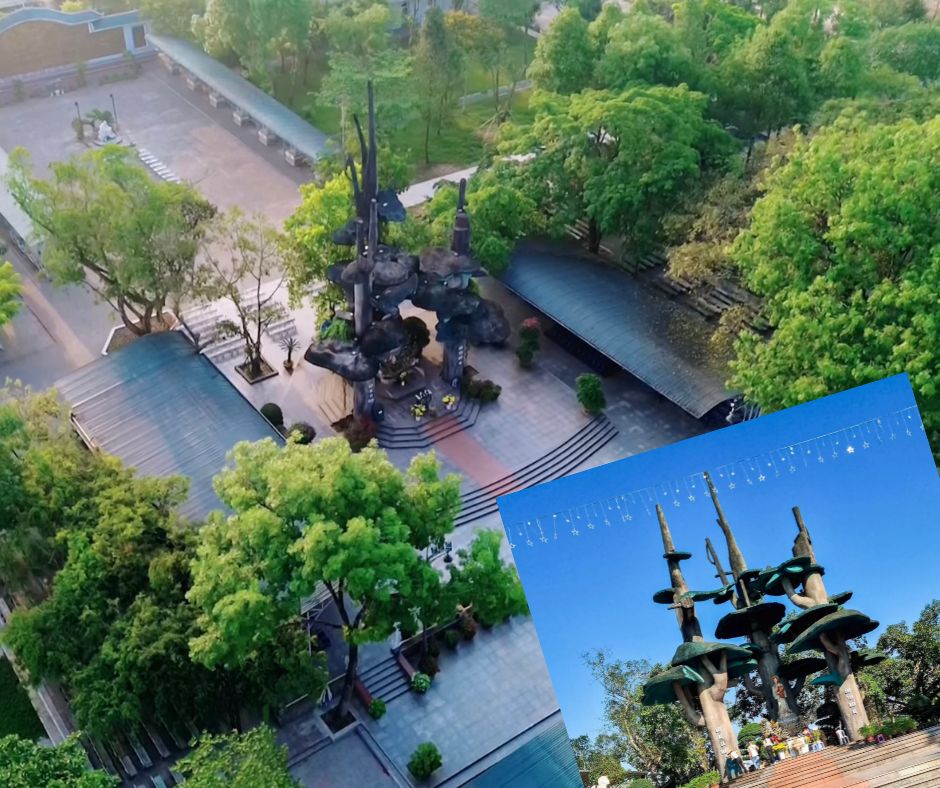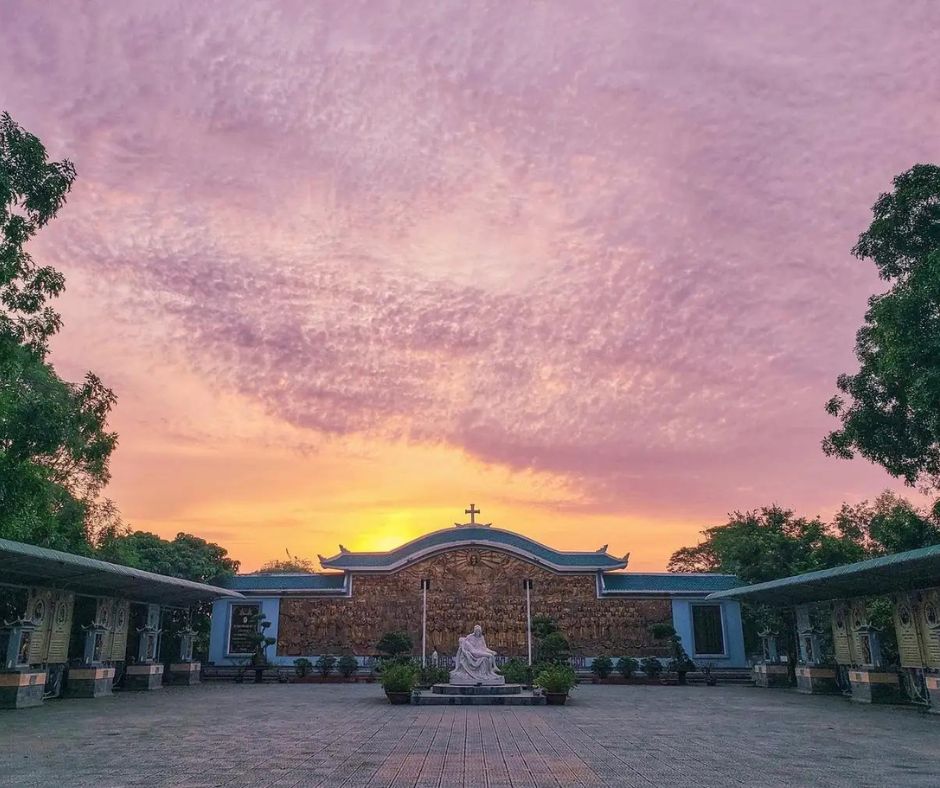La Vang Holy Land - the largest Catholic pilgrimage center in Vietnam.
Nestled in the heart of Quang Tri Province, Vietnam, La Vang Holy Land stands as a testament to the enduring fusion of history, culture, and spirituality. A pilgrimage site of profound significance, it beckons visitors with its serene ambiance and rich architectural heritage. La Vang Holy Land is more than a religious landmark; it is a living narrative of resilience and faith, reflecting the indomitable spirit of a community that has weathered the trials of time.
La Vang Holy Land Location:
You can find Duc Me La Vang Church, or our Lady of La Vang Catholic Church, in Phu Huong Village, Hai Phu commune, Hai Lang district, Quang Tri province. From Quang Tri ancient citadel to La Vang is only about 15 minutes by car. It will be very easy for you to move between these two places.

The History of La Vang Holy Land, Quang Tri Province:
The history of La Vang Church is intertwined with the resilience of the Catholic community in Vietnam. In 1798, amidst religious persecution during the reign of Emperor Canh Thinh, local Catholics sought refuge in the dense La Vang forest. Legend has it that the Virgin Mary appeared, providing solace and guidance to the beleaguered faithful. Since then, the story of the Virgin Mary’s appearance in the mountains and forests of La Vang has been passed down through generations.
As times changed, and after numerous construction efforts, in 1961, La Vang Holy Land was designated a ‘National Temple dedicated to the Immaculate Heart of Mary,’ and La Vang Sanctuary became a ‘Holy Center,’ a national exemplar.
After more than two hundred years, La Vang has transformed into a renowned landmark and the largest Catholic pilgrimage center in the country

Origin of the Name “La Vang”:
According to one theory, during the reign of King Canh Thinh, the Tay Son dynasty had an anti-Catholic policy. Therefore, to avoid the punishment of the Tay Son dynasty, many Catholics in the Quang Tri region fled to this land. This is a remote mountainous area, so in order to communicate with each other, they have to “shout” loudly, and “shout” loudly means “it resonates”. The name La Vang was born.
Another explanation is that when the parishioners ran to this land and suffered from an epidemic, Our Lady appeared at that time and instructed them to find a type of leaf called green leaf – drinking it would cure the disease. Write “yellow leaf” without accent as La Vang.
Another theory is that the place name “La Vang ward” existed before, in Co Vu village, located to the west of Dinh Cat post, later the provincial capital of Quang Tri, 4 kilometers and from Phu Xuan, i.e. Kinh Do Hue, 58 km north.

What to Explore?
After a long period of formation and development, La Vang Holy Land today is a large pilgrimage center with an area of 190,106m² divided into many subdivisions with different functions. If you have the opportunity to visit La Vang church, the following three key works will attract your attention from the moment you arrive:
Ancient Bell Tower: The ancient bell tower is the remaining relic of the old Basilica, built in 1925, inaugurated in 1928 and raised to a Basilica in 1961.
During the fiercest war, the cathedral was destroyed by bombs and bullets in 1972. As the years passed, only the bell tower remained of the cathedral and has been preserved as a historical relic to this day.

Basilica of Our Lady of La Vang
La Vang Basilica was started in 2013.
The Basilica of Our Lady of La Vang was built on an area of 13,464 square meters. 140m long in North-South direction, 104m wide in East-West direction with capacity of 5,000 people. This is the largest construction project of the Vietnamese Catholic Church to date.
The main color tones include blue, gray white and green to help balance the hot climate, creating a fresh and peaceful feeling.

Shrine of Our Lady of La Vang
The shrine area of Our Lady of La Vang is a structure built at the location where, according to legend, the Virgin Mary appeared in the past, under the corner of a banyan tree. This is where the statue of the Virgin Mary is placed and simulates the shape of a banyan tree and is where pilgrims come to pray.

In addition to the above three points, La Vang also has a number of works and relics that you can visit such as ancient wells, reliefs, and sculptures designed to be placed on many paths in the pilgrimage center, or The area where thanksgiving plaques are attached to those who came here to ask for favors and received them.

La Vang Pilgrimage Festival:
One of the highlights of the religious calendar is the La Vang Pilgrimage Festival, a vibrant and deeply spiritual event that draws thousands of pilgrims each year. Celebrated annually from August 14th to 15th, the festival commemorates the Assumption of the Blessed Virgin Mary. Pilgrims from across Vietnam embark on a spiritual journey to La Vang, partaking in processions, prayers, and communal activities.
The festival transforms the quiet surroundings into a bustling congregation of faith. The air is filled with hymns and prayers, creating an atmosphere charged with devotion and colle.

How to Get There?
Reaching La Vang Church is a meaningful journey. Travelers can get to La Vang by road, using different transportation like buses, taxis, or motorbikes. But Private Car Mentor’s private car service is the best choice for you because we always allow you to admire the beautiful landscape along the route. Therefore, when you book ourprivate car transfer. our driver will also stop at La Vang church for you to visit and take photos on the way. Please refer the map below to get more details about where La Vang Church is.
If you are staying in Dong Hoi or Phong Nha and want to go to Hue, Danang or Hoi An, you can book our private car transfer service and customize your itinerary to visit La Vang Church such as: Phong Nha to Hue by private car, Phong Nha to Hoi An by private car, Phong Nha to Da Nang by private car.
If you are staying in Hue city, you can visit La Vang Church by booking a Hue DMZ tour or customizing your trip from Hue to Phong Nha by private car and visiting La Vang Church.
If you are staying in Da Nang or Hoi An, you can visit La Vang Church by customizing your trip from Hoi An to Phong Nha by car or from Da Nang to Phong Nha by private car. Alternatively, you can opt for a DMZ one-day tour from Da Nang or Hoi An. Please note that in such a case, it will be a long day for you.

In conclusion, Private Car Mentor has just shared information about La Vang Holy Land – the most famous Catholic holy land in Vietnam. If you have the opportunity to travel to Quang Tri, do not forget to visit the Holy Land of La Vang! It is truly one of the best places in Quang Tri to gain more knowledge about Catholics and Our Lady of La Vang.

